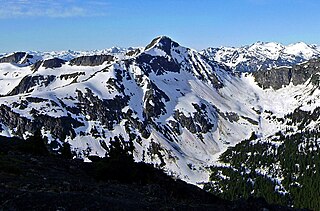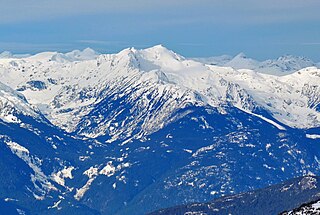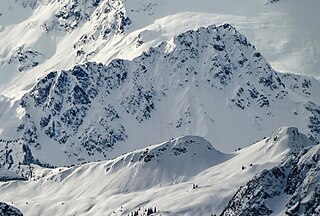
Mount Chief Pascall is a 2,206-metre (7,238-foot) mountain summit located in the Joffre Group of the Lillooet Ranges, in southwestern British Columbia, Canada. It is situated 26 km (16 mi) east of Pemberton, 8 km (5 mi) southwest of Duffy Lake, and within Nlháxten/Cerise Creek Conservancy. Cayoosh Pass lies immediately northwest of the mountain, with Cayoosh Mountain on the opposite side of the pass. Its nearest higher peak is Joffre Peak, 2.1 km (1 mi) to the south, and Mount Rohr rises 5 km (3 mi) to the northeast. Precipitation runoff from the peak drains into tributaries of Cayoosh Creek.

Mount Taylor is a 2,318-metre (7,605-foot) mountain summit located in the Coast Mountains, in Joffre Lakes Provincial Park, in southwestern British Columbia, Canada. It is part of the Joffre Group, which is a subset of the Lillooet Ranges. It is situated 21 km (13 mi) east of Pemberton, and 7 km (4 mi) northeast of Lillooet Lake. Its nearest higher peak is Slalok Mountain, 1.9 km (1 mi) to the east. Precipitation runoff from the peak drains into Joffre Creek, a tributary of the Lillooet River. The mountain's name was submitted by Karl Ricker of the Alpine Club of Canada to honor Ada C. Taylor, a Pemberton pioneer and the first nurse in that community. The toponym was officially adopted January 23, 1979, by the Geographical Names Board of Canada.

Duffey Peak is a 2,219-metre (7,280-foot) mountain summit located in southwest British Columbia, Canada.

Handcar Peak is a 2,338-metre (7,671-foot) mountain summit located in the Railroad Group of the Coast Mountains, in the Pemberton Valley of southwestern British Columbia, Canada. It is situated 38 km (24 mi) northwest of Pemberton and 3 km (2 mi) west of Locomotive Mountain. Precipitation runoff from the peak drains into Sampson Creek and Buck Creek which are both tributaries of the Lillooet River. Handcar Peak is more notable for its steep rise above local terrain than for its absolute elevation as topographic relief is significant with the summit rising over 2,050 meters (6,725 ft) above Lillooet River and Pemberton Valley in approximately 4 km (2.5 mi). The mountain's name was proposed in 1978 by mountaineer Karl Ricker of the Alpine Club of Canada, in association with Railroad Pass, Railroad Creek and other railroad-related names of the immediate vicinity. The toponym was officially adopted January 23, 1979, by the Geographical Names Board of Canada.

Ipsoot Mountain is a 2,576-metre (8,451-foot) glaciated summit located in southwest British Columbia, Canada.

Rhododendron Mountain is a 2,523-metre (8,278-foot) glaciated summit in British Columbia, Canada.

Cloudraker Mountain is a 2,385-metre (7,825-foot) glaciated summit in British Columbia, Canada.
Whitecap Mountain is a 2,918-metre (9,573-foot) summit in British Columbia, Canada.

Mount Sir Richard is a 2,681-metre (8,796-foot) glaciated summit in British Columbia, Canada.

The Lecture Cutters are 2,524-metre (8,281-foot) mountain peaks in British Columbia, Canada.

Outlier Peak is a 2,422-metre (7,946-foot) mountain summit in British Columbia, Canada.

Nivalis Mountain is a 2,659-metre (8,724-foot) mountain summit in British Columbia, Canada.

Mount Neal is a 2,552-metre (8,373-foot) glaciated summit in British Columbia, Canada.

Carcajou Peak is a 2,239-metre (7,346-foot) mountain summit in British Columbia, Canada.

Mount Moe is a 2,664-metre (8,740-foot) glaciated summit in British Columbia, Canada.

Twin Goat Mountain is a 2,128-metre (6,982-foot) summit in British Columbia, Canada.

Shudder Mountain is a 2,671-metre (8,763-foot) summit in British Columbia, Canada.

Icecap Peak is a 2,435-metre (7,989-foot) glaciated summit in British Columbia, Canada.

Klowa Mountain is a 2,527-metre (8,291-foot) summit in British Columbia, Canada.

Mount Pitt is a 2,487-metre (8,159-foot) summit in British Columbia, Canada.
























